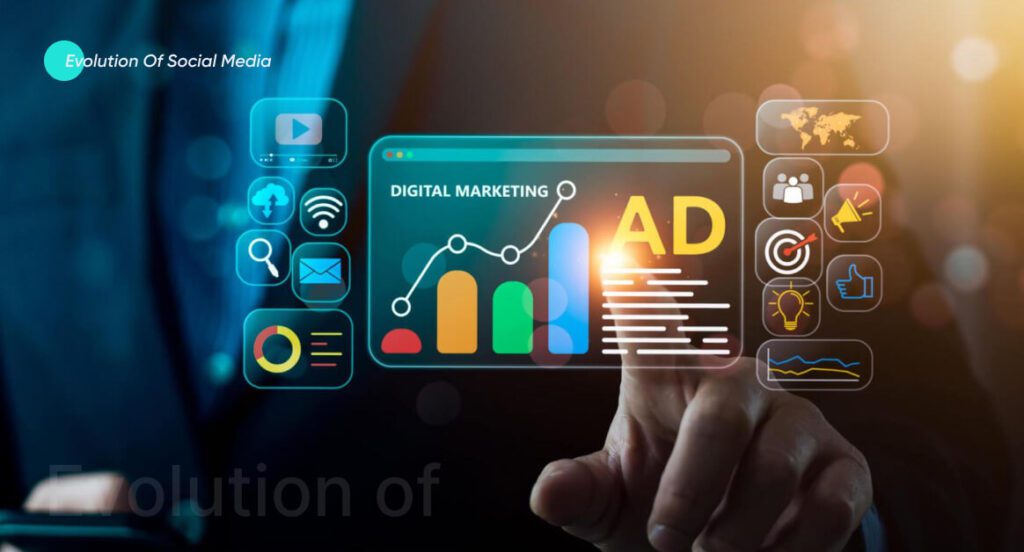Technologies Evolving Social Media
Is social media still a platform for social interaction, or has it become an illusion for communication?
The social media industry is evolving at an unprecedented rate. While it was a means of communication for people back in the day, it has quickly become a commercial space for businesses to tap consumers. Integrating marketing, psychology, and technology with social media has transformed it into a mind-reading guru. Today, innovations in social media are all about digital commerce and consumer engagement. Social media platforms such as Instagram, Facebook, TikTok, and YouTube display advertisements tailored to your preferences and interests for products and services, often leaving you questioning your privacy and control.
In this blog, we’ll discuss how social media has evolved over the years and what you should expect from it in the future.
So, let’s dive in!
The Evolution of Social Media – A Timeline and Key Events

1997:
Remember Six Degrees? It was the world’s first social networking site and connected hundreds of thousands of people with others. It was launched to help people connect with strangers. People could create lively profile pages, build connections, and send messages to their network.
2000:
The Y2K problem, also known as the Millennium Bug, was a significant technological issue that could potentially cause digital chaos. However, through effective Y2K compliance measures, the problem was resolved, and the order was successfully restored.
2001-2002:
Despite its one million users, Six Degrees faced its demise and was shut down forever. in 2002 Friendster was launched in March as a non-subscription-based dating site. However, it quickly became a social space to interact, socialize with old friends, and make new ones. The socially awkward finally had a platform to make lots of digital friends!
In December 2002, LinkedIn was launched to create a social network for businesses. It addressed a clear need in the professional world and connected people with career opportunities. It became a valuable tool for HR professionals, hiring agencies, and headhunters, making their jobs much easier.
2003:
Anderson and DeWolfe created MySpace after being inspired by Six Degrees and Friendster. It was a social networking site where users could customize their profiles and pages to their liking. It was the first social network company to reach a global audience!
Skype was also launched this year to facilitate instant messaging and voice/video calling services (VoIP).
2004
Facebook entered the social media race. Zuckerberg and his friends addressed the problem of the lack of avenues for students to connect around Harvard and created Facebook, intending to facilitate it. It quickly blew up and extended to other Ivy League universities like Yale, Stanford, and Columbia.
Flickr, Orkut, and Tagged were closed behind and launched in the same year.
2005
In February, YouTube captured a huge gap in the market and was launched to facilitate the sharing of videos worldwide.
In June, Reddit was established to create a platform where users could share and discuss links and add content from the internet.
By July, MySpace had reached 22 million users and had become the primary platform for social interaction among friends. News Corporation acquired MySpace for $580 million.
2006
In July, Twitter went live. It was created to communicate with a small group of people with short messaging systems.
In October, Google acquired YouTube for $1.65 billion. It was Google’s second-largest acquisition and put them ahead of the competitors. Google became a pioneer by developing a video hub and set itself as a default platform for user-generated platforms.
In September, Facebook’s “Newsfeed” went live and became more popular among the masses.
2007
Twitter introduced hashtag (#), and it quickly became a hit because it made it easier for users (technical and non-technical) to find relevant content on the app. It helped filter tweets and make user experience a lot better.
Tumblr, Justin.tv, and FriendFeed were launched to make microblogging, feed aggregation, and live-streaming easier for users.
2008 –2009
Spotify launched in October to combat music piracy and became a popular solution for music listeners. In 2009, Facebook announced that its cash flow was positive for the first time since its inception after an estimated $716M investment. Facebook acquired FriendFeed for $15 million in cash and 32.5 million in stocks. In November, WhatsApp was launched as an alternative to SMS.
2010
In March, Pinterest was launched as a visual discovery tool to enable people to share inspiration for their interests and projects. It was a virtual replacement for paper catalogs.
In October, Instagram was launched to facilitate photo-sharing among users. Its popularity skyrocketed, and millions of people quickly joined it.
Path and Quora were also launched to create a purely mobile-based social networking site and a Q&A platform for users.
2011
Snapchat was launched to tap the people who wanted to ‘live in the moment’ and ‘express themselves freely’ through disappearing content. This platform was more closely related to how people communicate in real life. Snapchat liberated users by letting go of the pressure to be popular and pretty according to Instagram’s standards.
Skype was acquired by Microsoft and Google+, Keek and Twitch were launched in the social media industry, each with their unique value proposition.
2012
In April, Facebook acquired Instagram for $1 Billion because Facebook saw it as a threat and capable competitor. It put Facebook in a feasible position to compete with giants like Google+ and Twitter.
In October, Facebook reached 1 billion active users and became a king in digital communication. Snapchat launched a short video-sharing app, while Tinder was launched to revolutionize online dating.
2013
Vine was launched as a video-sharing platform. Simultaneously, Instagram also launched its video-sharing feature. Intranet organizational communication was made easier and better with Slack, an instant messaging service for internal communication.
With an increasing number of people jumping on the content creator bandwagon, Patreon was created. It was a crowdfunding site that facilitated content creators on their journey to make content.
Telegram was launched and offered messaging, media sharing, file exchange, private/group calls, public livestreams, and live location sharing.
2015
Snapchat’s disappearing snaps and stories weren’t enough to engage users. They introduced “filters” to make the user experience more interactive. These filters garnered much attention, especially from Late Millennials and GenZ, and started a completely new trend in the social media industry that is still going strong.
Discord, a free messaging and video/voice calling service designed for gamers, was launched.
2016
After its success, Snapchat rebranded itself as Snap Inc. and released the first ever smart sunglasses called “Spectacles.” However, they failed soon after they were launched. Reports stated that the company lost a staggering $40 million in unsold inventory because only 0.08% of the total Snapchat users bought them.
Mastodon was launched in 2016 to add some form of freedom to the social media space. It was an open-source platform where users were free to create independent communities.
2018
Parler was introduced as a free speech and unbiased alternative to combat large and regulated social media interaction. Path terminated its services in October.
2020-2021
Clubhouse was launched as an audio-chat social networking application. BeReal was another social media application that was launched to emphasize user authenticity. In 2021 Jason Miller, a former advisor to U.S. President Donald Trump, launched Gettr, an alt-tech social media platform targeting conservatives.
Moreover, Truth Social, a social media platform, was created by Trump Media & Technology Group. It competed with Parler, Gab, and Mastodon as an alternative to Twitter and Facebook. It had Mastodon at its backend.
2022
Elon Musk acquired Twitter with a historic $44 billion deal. He made significant changes to how the application functioned. His new policies caused unrest among millions of Twitter users.
2023
Threads emerged as a competitor for Twitter after its acquisition. It aimed at providing a similar experience to users on Twitter. Meta’s strategic move was to capture the market that Twitter was losing and offer Instagram-like aesthetics to users. It gained massive popularity, and over 30 million accounts were created in 24 hours!
Importance of Technology in Social Media

A common question aspiring entrepreneurs must understand to design their value proposition is, “What technology led to the growth of new media, and how can I capitalize on it?”
The media evolution is incomplete without discussing the fascinating integration of technology and social media. They have truly transformed connectivity. While everyone’s social media journey began with personal computers, something more substantial, portable, and accessible was needed to keep users hooked. This led to the emergence of Mobile Apps; they quickly became the real stars of the social media industry. Almost 91% of teen social media users interact with applications through their mobile devices!
Technology has built the social media industry’s foundation and enabled the growth of several alternate channels for social connection. Moreover, technological advancements like geotagging, APIs, VR, AI and QR codes have also contributed to making social media a mode of communication that has stood the test of time.
- Technological advancements have significantly elevated social media usage through geotagging, fostering real-time connections and personalized interactions. Local businesses leverage geotagging for targeted promotions, enhancing user engagement within local communities.
- APIs facilitate seamless cross-platform integration, enriching user experiences and diversifying content sources.
- Virtual Reality (VR) provides immersive social interactions and captivates users with 360-degree content, prolonging engagement.
- Artificial Intelligence (AI) ensures personalized content delivery and maintains a secure environment through automated moderation, fostering user trust.
- QR codes streamline user interactions, offering quick access and integrating marketing campaigns.
- Gamification elements incentivize prolonged engagement, collectively shaping a technologically driven surge in social media usage.
Technology also ensures that social media is a safe and accessible space for everyone with real-time content. It ensures an optimized user experience through automation, e-commerce, inter-app integration, and more ideas are being incorporated with social media innovations.
Technologies Driving the Future of Social Media

1. IoT
Internet of Things (IoT) is heavily used for social media marketing by industry giants like Disney, Amazon, and eBay. It has also enhanced connectivity among users across all their devices and improved business conversions. It forms an intelligent network that extracts valuable demographic information to capture more users.
Recent updates reveal that integrating IoT and social media has given birth to SIOT, which can help people establish a stronger connection with their devices.
2. Blockchain
Decentralized social media is a hot topic in the social media industry, and rightfully so! Many businesses are experimenting with social media and blockchain to start a new era in this industry. Blockchain is a great way to create a space that offers fair compensation to all the parties involved.
For example, social media platforms have an ad-based business model. However, they offer unequal compensation for content creators on the platforms. With blockchain, a smart contract between the content creator and the social media application can be enacted, ensuring the creators get their fair share. Moreover, blockchain is also working towards mitigating internet censorship.
3. RFID (Radio Frequency Identification Tags)
RFIDs are quickly being adapted to the social media industry because they make the exchange of information so much easier. RFID is a storage device with a unique serial number. They are widely used at the NFL and Super Bowl to optimize player tracking and ensure a better experience for the audience. They are also utilized in music concerts by mainstream pop singers like Coldplay and Taylor Swift to track their audience movement. They are coupled with LED wristbands to create a lively concert experience.
4. Artificial Intelligence
Artificial Intelligence (AI) is quickly coming out on top among all the technologies that impact the social media industry. AI is a major component of all the social media platforms active today.
Some popular social technology examples for AI include Facebook and Snapchat. Facebook uses machine learning to recognize faces and improve search functionality. Similarly, when using filters, Snapchat employs computer vision to track physical features for an optimized user experience.
5. Augmented Reality and Virtual Reality (AR & VR)
Mixed reality and Augmented Reality (AR) are most popular application features. AR has witnessed mass popularity, especially because of its integration with face filters. Its greatest example is that of Snapchat. Moreover, many social media advertisements use AR to engage users and bring conversions. On the other hand, virtual reality (VR) provides users with immersive social experiences. They can engage in virtual meetups and events. They can also enjoy 360-degree content view for a unique experience.
How can Coding Pixel help you build a social media application?
The social media industry is a wildly evolving space. If you want to survive here for the long-run you need to adapt to the above-mentioned technologies as soon as you can. If you’re unsure about the process of incorporating them into your social media application, feel free to reach out to our experts. Our developers have over eight years of experience in app development and have developed 500+ successful applications.
We can help you build a scalable and functional application for your business. See our Website Development Service. ![]()
BONUS CONTENT:
What is Facebook doing?
Facebook embraced a mobile-first approach between 2015 to 2020, acquiring Instagram and WhatsApp to broaden its reach and influence. It introduced innovative features for mobile users, cementing its adaptability and role in digital communication. Facebook’s cultural influence has been significant, but it has faced scrutiny and controversies since 2020. In October 2021, Facebook became Meta, shifting focus towards the Metaverse, a digital realm blending virtual and augmented reality. Meta aims to redefine online interaction and experiences with innovations like virtual reality headsets and generative AI.
FAQ
In 2050, social media will become more immersive and interactive with virtual and augmented reality. Artificial intelligence will enable personalized content, and social commerce will be integrated with e-commerce. Decentralized social media platforms could emerge, giving users more control over their data and privacy.
AI is changing social media through chatbots, automated content creation, personalization, sentiment analysis, and AI-assisted design.
Social media platforms change algorithms to improve user experience, combat spam, and increase effectiveness for advertisers. Moreover, these platforms often modify their algorithms to gain a competitive advantage and improve revenue.
Masifa is a Content Specialist with a bachelor’s degree in marketing and over three years of experience in content marketing and the IT industry. She is passionate about writing and talking about website and mobile app development, e-commerce, and advancements happening in the IT Industry. She creates engaging and user-centric content to optimize digital experiences for these niches. When she is not creating content, you can find her buried in a good book.